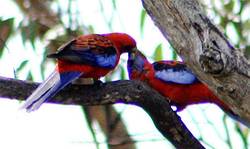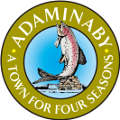About Crimson Rosellas
Useful information for birdwatchers and for recording data in your rosella nesting box diary.
The Breeding Season
Prepare for the nest box to be occupied from early November until early autumn, as up to 3 nesting pairs cycle through their breeding phase. This is a later start than in other areas, due to our 1200-1400m altitude and its impact on seasons.
The nesting and breeding calendar of the crimson rosella begins in August - early spring, when nature urges females to prepare for the breeding season. She must find a nest, choose a mate, prepare for egg production and prepare to rear chicks to fledging stage. Once the chicks are fledged and capable of flight, they usually vacate the nest in 7 to 10 days.
Fortunately, it is relatively easy to track these breeding cycle stages by observing the behaviour of the pair at the nest.
Note: It can be difficult to distinguish between the sexes. A reasonable guide in distinguishing pairs is that the adult male is usually 10% bigger than the female.
Nest Site Selection
Choosing a nest site is a joint decision made by the prospective rosella pair. Site selection is an important bonding step in a relationship that will heavily rely on cooperation and the sharing of family responsibilities by the partners.
The preferred site is a hollow bole in a large tree, 2 metres plus above ground level, NE facing, and with protection from the prevailing wind at that time (usually SE). Suitable nest sites are not abundant and there will be competition for suitable sites, especially where abundant feed is at hand.
Pairs can be seen visiting and revisiting prospective sites, until a site is confirmed as vacant and available for occupancy.
Observed behaviour: Pairing, visiting nest sites, hollow or bole inspection, revisiting prospective sites, staying at the site for several successive days to affirm occupancy.
Occupancy

Once the decision is made to occupy the site, the female will stay at the nest and will prepare a dust base of shredded bark for the coming eggs and rarely leave the nest.
During this 10 day confinement, the male will forage widely and bring food to feed the female. This is also a bonding behaviour to confirm the ability of the male to care for a brood and raise offspring.
The female may terminate nesting behaviour if the male is delinquent (fails to return to the nest) or if the food supply is insufficient to sustain a successful brood.
Occupied sites will be defended fiercely by the female while the male feeds and brings food and bark pieces to dress the nest.
Observed behaviour: Male feeding female, pair defending nest, male collecting small bark pieces for female to chew to dust.
Brooding Eggs and Incubation
Crimson Rosellas lay between 4 and 6 eggs over a period of 7-10 days and incubate these for 20 days to hatching. During this time, the female is fed almost entirely by the male, with only very occasional excursions from the nest.
Observed behaviour: female predominantly fed by male at the entrance to the nest, frequent foraging behaviour by the male.
Growth and Fledging
Once hatched, the task of feeding at the entry of the nest falls both to males and females.
The hatchlings or 'naked' chicks rapidly gain weight and develop fluffy down feathers for warmth and protection. After about 15 days, the nestling's tail and flight feathers will over-grow the thin down undercoat, and the bones and muscles develop in wings and body to allow crawling and hopping, and later flight.
At the nestling stage, chicks are most vulnerable to predation by currawongs, other hunting birds, and feral cats. Nest box design is important in preventing predators reaching deep into the nest to steal chicks.
Newly green-feathered juveniles will emerge from the nest to feed at the entrance, exercise flight muscles and gain experience of the canopy and environment. First experimental flight is tested shortly after emerging from the nest, after hops and scaling branches and retreating to the nest.
Fledglings will accompany their parents and siblings on foraging flights to learn food sources and social etiquette and parrot behaviour. After the fledged chicks are about 35 days old, the parent pair prepare to release their near-adult charges to life out of the nest as subordinate society members of a mixed flock.
A pair will usually have only one clutch of 4-6 white eggs per year, occasionally two; and will usually attempt to return to the same nest in the following year.
Observed behaviour: adults feeding chicks at the nest entry, regular emergence of chicks, flight training, socialisation, presence of threats from Currawongs and other bird species.
Adult Life
After the fledglings leave the nest, they stay with their parents for about a month and join a local foraging group or flight. The immature birds gradually lose their green plumage, which is replaced by the mature colours (crimson and blue feathers) by about 8 months of age. Females achieve sexual maturity at 18 months, but males take up to 2 to 3 years. Birds pair for life and remain in close contact throughout the year.
